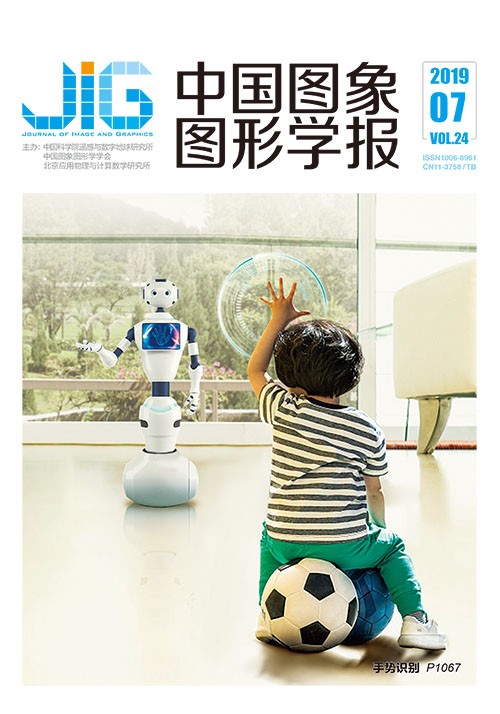
面向像对直线特征匹配的线特征矫正与提纯方法
摘 要
目的 像对直线特征匹配是计算机视觉的重要研究内容,现有这类匹配方法均存在不同程度的误匹配问题。导致此问题的主要因素包括直线检测结果没有位于图像的真正边缘处、缺乏匹配线对的一致性校验。为此本文提出一种面向像对直线特征匹配的线特征矫正与提纯方法。方法 首先提取像对的边缘特征获得二值化边缘图,通过边缘梯度图及梯度矢量图(GVF)建立梯度引力图。其次,采用直线检测方法提取像对的直线特征,并通过梯度引力图矫正直线位置。最后,采用点特征匹配结果计算像对极线,并结合直线匹配结果确定最后的局部校验特征区域,通过随机抽样一致小邻域范围内特征相似性校验直线匹配结果,从而剔除误匹配直线。结果 对一组宽基线像对进行匹配实验,与直接采用直线匹配算法获得的匹配结果相比,矫正后的匹配结果剔除了大部分误匹配线对,将匹配准确率从50%提高到84%,继续提纯该匹配结果获得了100%的匹配准确率。在另一组宽基线像对的匹配实验中,经本文方法处理后的匹配准确率提高近30%。与前两组实验相比,第3组实验的像对摄影姿态变化不大,仅在尺度上有所区别,经本文方法处理后配准率从92%提高到100%。结论 采用本文方法可以大幅提高像对直线特征匹配的准确率,同时该方法可以很容易对其他直线匹配结果进行校正与提纯,具备较高的实用性。
关键词
Line feature correction and purification for matching straight lines of image pair
Jia Di, Li Yuxiu, Zhao Mingyuan, Zhu Ningdan(School of Electronic and Information Engineering, Liaoning Technical University, Huludao 125105, China) Abstract
Objective Linear feature matching is an important research content of computer vision. Existing matching methods exhibit different degrees of mismatching. The main factors leading to this problem include the following: the existing line detection results are not located at the real edge of the image, and local consistency checking for matching lines is lacking. For this reason, a line feature correction and purification method for image matching of linear features is proposed. Method First, the edge features of the pair are extracted to obtain the binarized edge map. The edge gradient map and gradient vector flow are used to establish the gradient gravitational map. Second, the line detection method is used to extract the straight line features of the pair, and the new endpoints are determined by shortening the endpoints of these straight lines. Then, the distance gravitation map is used to calculate the position of the new endpoints to create new straight lines. Subsequently, a method of extending the new lines is proposed to ensure that the length of the original line is consistent. Finally, the point feature matching result is used to calculate the image pair epipolar line, and the line matching result is combined to determine the final check local feature area. The mismatched straight lines are eliminated by randomly sampling the feature matching in the small neighborhood to verify the straight lines matching. Result Three different image pairs were selected for the experiments. A wide baseline stereo pairs was selected for the first experiment. Experimental result shows that most straight lines on the ground imperfectly fit on the ground pattern. Correction result shows that straight lines of this part were corrected to the edge of the pattern. In addition, the straight lines of doors and windows were also offset or inclined to the interior. Such lines were also corrected to the edges of doors and windows. The analysis outcome of experimental data indicated that many wrong matching lines were observed in the matching results obtained by direct line matching algorithm. However, the linear correction processed by our method could improve the matching accuracy from 50% to 84%. Although a small number of wrong matching lines were observed, 100% matching accuracy could be obtained by refining this matching result through our method. Another wide baseline image pair was selected for the second experiment. Experimental result indicated that the straight lines extracted near the edge of flowerpot show that gaps between the actual edge and extraction result. The lines were located at the edge of the flowerpot through our method. The deviation of the line position is highly evident near the window frame, and the corrected straight lines were pulled back to the correct position. The analysis outcome of experimental data indicated that the matching accuracy was also increased by 30%. An image pair of scale changed was selected for the third experiment. Experimental result demonstrated that the lines are regularly detected, but the straight lines in the horizontal and vertical directions deviate to the real position. This problem was solved after correction. Moreover, some tilted lines were also pulled back to the real edge. Only a slight scale difference in the third image pair was observed, and the matching accuracy increased from 92% to 100% compared with the previous experiments. Conclusion This work aims to improve the registration accuracy of image pair. A general method of rectifying and purifying straight line features and its implementation process is proposed. A gradient gravity map is developed by combining gradient graph and gradient vector graph of edge graph. Accordingly, the positions of straight lines are corrected. The polar line obtained by matching points and line matching results are used to check the regional similarity for eliminating wrong matching lines. Three image pairs were tested to detect the linear registration rate, alignment rate after straight line correction, and matching result of purification matching results. Experimental results show that the average matching accuracy increased by approximately 30%. The method of this work can greatly improve the accuracy of matching the line features and easily correct and purify other line matching results and exhibits high practicability.
Keywords
|



 中国图象图形学报 │ 京ICP备05080539号-4 │ 本系统由
中国图象图形学报 │ 京ICP备05080539号-4 │ 本系统由